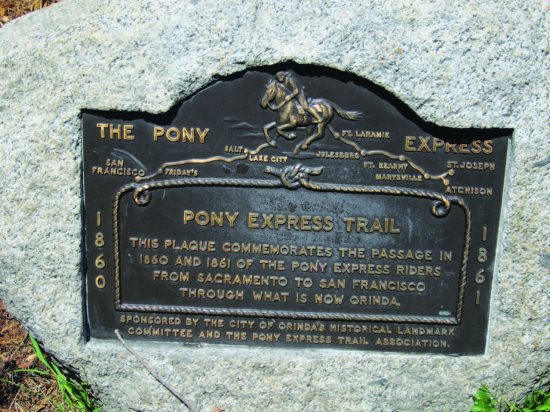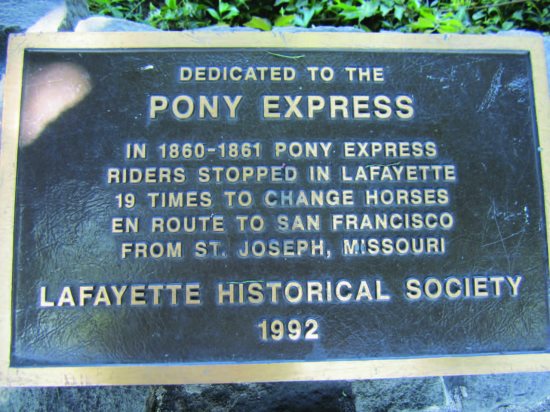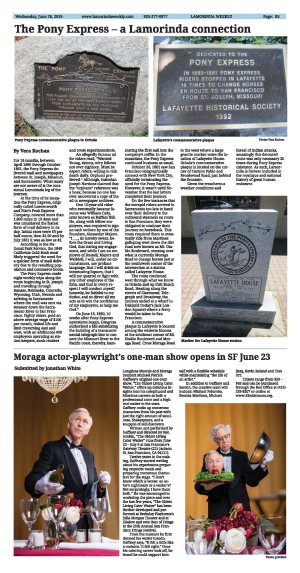| | Published June 26th, 2019
| The Pony Express - a Lamorinda connection
| | | By Vera Kochan |  | | Pony Express commemorative plaque in Orinda Photo Vera Kochan |
For 18 months, between April 1860 through October 1861, the Pony Express delivered mail and newspapers between St. Joseph, Missouri, and Sacramento. What many are not aware of is the occasional Lamorinda leg of the journey.
 At the time of its inception the Pony Express, originally called Leavenworth and Pike's Peak Express Company, covered more than 1,800 miles in 10 days and was considered the fastest form of mail delivery in its day. Initial rates were $5 per half ounce, then $2.50 and by July 1861 it was as low as $1.
At the time of its inception the Pony Express, originally called Leavenworth and Pike's Peak Express Company, covered more than 1,800 miles in 10 days and was considered the fastest form of mail delivery in its day. Initial rates were $5 per half ounce, then $2.50 and by July 1861 it was as low as $1.
 According to the National Park Service, the 1849 California Gold Rush most likely triggered the need for a quicker form of mail delivery due to the resulting population and commerce boom.
According to the National Park Service, the 1849 California Gold Rush most likely triggered the need for a quicker form of mail delivery due to the resulting population and commerce boom.
 The Pony Express made eight weekly trips along the route beginning in St. Joseph and traveling through Kansas, Nebraska, Colorado, Wyoming, Utah, Nevada and arriving in Sacramento where the mail was sent via steamer down the Sacramento River to San Francisco. Eighty riders, paid an above average wage of $100 per month, risked life and limb traversing east and west, with an additional 400 employees operating as station keepers, stock tenders and route superintendents.
The Pony Express made eight weekly trips along the route beginning in St. Joseph and traveling through Kansas, Nebraska, Colorado, Wyoming, Utah, Nevada and arriving in Sacramento where the mail was sent via steamer down the Sacramento River to San Francisco. Eighty riders, paid an above average wage of $100 per month, risked life and limb traversing east and west, with an additional 400 employees operating as station keepers, stock tenders and route superintendents.
 An allegedly famous ad for riders read, "Wanted: Young, skinny, wiry fellows not over eighteen. Must be expert riders, willing to risk death daily. Orphans preferred." Although, historian Joseph Nardone claimed that the "orphans" reference was a hoax, because no one has ever uncovered a copy of the ad in newspaper archives.
An allegedly famous ad for riders read, "Wanted: Young, skinny, wiry fellows not over eighteen. Must be expert riders, willing to risk death daily. Orphans preferred." Although, historian Joseph Nardone claimed that the "orphans" reference was a hoax, because no one has ever uncovered a copy of the ad in newspaper archives.
 One 15-year-old rider who eventually became famous was William Cody, later known as Buffalo Bill. He, along with fellow employees, was required to sign an oath written by one of the founders, Alexander Majors. "I ___, do hereby swear, before the Great and Living God, that during my engagement, and while I am an employee of Russell, Majors and Waddell, I will, under no circumstances, use profane language, that I will drink no intoxicating liquors, that I will not quarrel or fight with any other employee of the firm, and that in every respect I will conduct myself honestly, be faithful to my duties, and so direct all my acts as to win the confidence of my employers, so help me God."
One 15-year-old rider who eventually became famous was William Cody, later known as Buffalo Bill. He, along with fellow employees, was required to sign an oath written by one of the founders, Alexander Majors. "I ___, do hereby swear, before the Great and Living God, that during my engagement, and while I am an employee of Russell, Majors and Waddell, I will, under no circumstances, use profane language, that I will drink no intoxicating liquors, that I will not quarrel or fight with any other employee of the firm, and that in every respect I will conduct myself honestly, be faithful to my duties, and so direct all my acts as to win the confidence of my employers, so help me God."
 On June 16, 1860, 10 weeks after Pony Express operations began, Congress authorized a bill subsidizing the building of a transcontinental telegraph line to connect the Missouri River to the Pacific coast, thereby, hammering the first nail into the company's coffin. In the meantime, the Pony Express continued business as usual.
On June 16, 1860, 10 weeks after Pony Express operations began, Congress authorized a bill subsidizing the building of a transcontinental telegraph line to connect the Missouri River to the Pacific coast, thereby, hammering the first nail into the company's coffin. In the meantime, the Pony Express continued business as usual.
 October 26, 1861 saw San Francisco telegraphically connect with New York City, officially terminating the need for the Pony Express. However, it wasn't until November that the last letters completed their journey.
October 26, 1861 saw San Francisco telegraphically connect with New York City, officially terminating the need for the Pony Express. However, it wasn't until November that the last letters completed their journey.
 On the few instances that the intrepid riders arrived in Sacramento too late to hand over their delivery to the outbound steamers en route to San Francisco, they were obligated to continue their journey on horseback. This route required them to eventually ride from Martinez galloping west down the dirt road now known as Mt. Diablo Boulevard, crossing over what is currently Moraga Road to change horses just at the south/west corner of the intersection at a station called Lafayette House.
On the few instances that the intrepid riders arrived in Sacramento too late to hand over their delivery to the outbound steamers en route to San Francisco, they were obligated to continue their journey on horseback. This route required them to eventually ride from Martinez galloping west down the dirt road now known as Mt. Diablo Boulevard, crossing over what is currently Moraga Road to change horses just at the south/west corner of the intersection at a station called Lafayette House.
 The route continued west through what we know as Orinda and up Fish Ranch Road. Heading along the streets of Claremont, Telegraph and Broadway, the journey ended at a wharf in Oakland (today's Jack London Square) where a ferry would be taken to San Francisco.
The route continued west through what we know as Orinda and up Fish Ranch Road. Heading along the streets of Claremont, Telegraph and Broadway, the journey ended at a wharf in Oakland (today's Jack London Square) where a ferry would be taken to San Francisco.
 A commemorative plaque in Lafayette is located among the wisteria blooms at the southeast corner of Mt. Diablo Boulevard and Moraga Road. Cross Moraga Road to the west where a large granite marker notes the location of Lafayette House. Orinda's commemorative plaque is located on the corner of Camino Pablo and Brookwood Road, just behind the fountain.
A commemorative plaque in Lafayette is located among the wisteria blooms at the southeast corner of Mt. Diablo Boulevard and Moraga Road. Cross Moraga Road to the west where a large granite marker notes the location of Lafayette House. Orinda's commemorative plaque is located on the corner of Camino Pablo and Brookwood Road, just behind the fountain.
 Given the treacherous weather conditions and threat of Indian attacks, amazingly this detoured route was only necessary 20 times during Pony Express existence. As such, Lamorinda is forever included in the mystique and national history of great human endeavor.
Given the treacherous weather conditions and threat of Indian attacks, amazingly this detoured route was only necessary 20 times during Pony Express existence. As such, Lamorinda is forever included in the mystique and national history of great human endeavor. |
 | | Lafayette's commemorative plaque Photo Vera Kochan |  | | Marker for Lafayette House station Photo Vera Kochan | | | | | | | | | |





